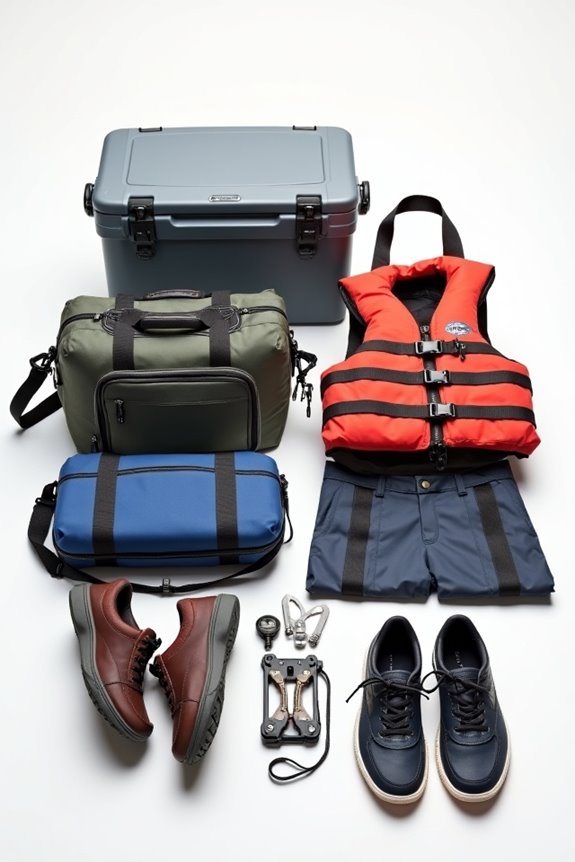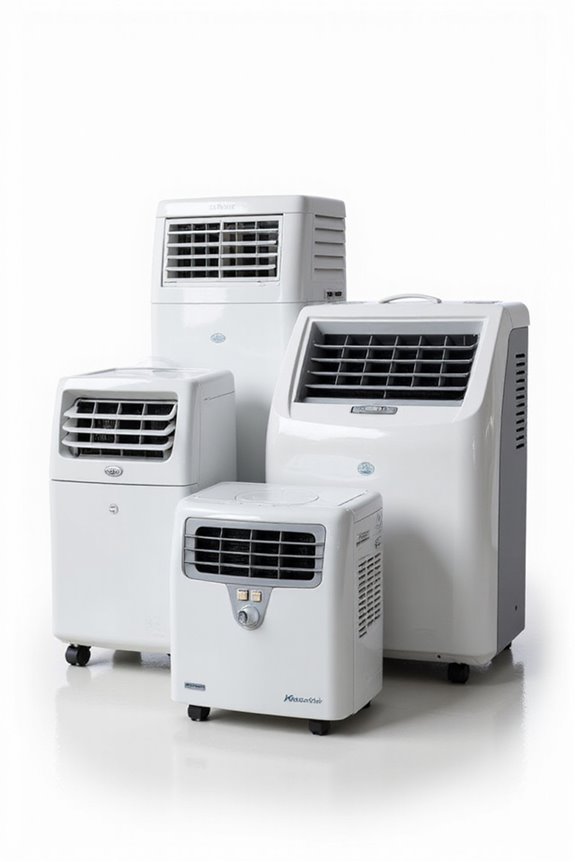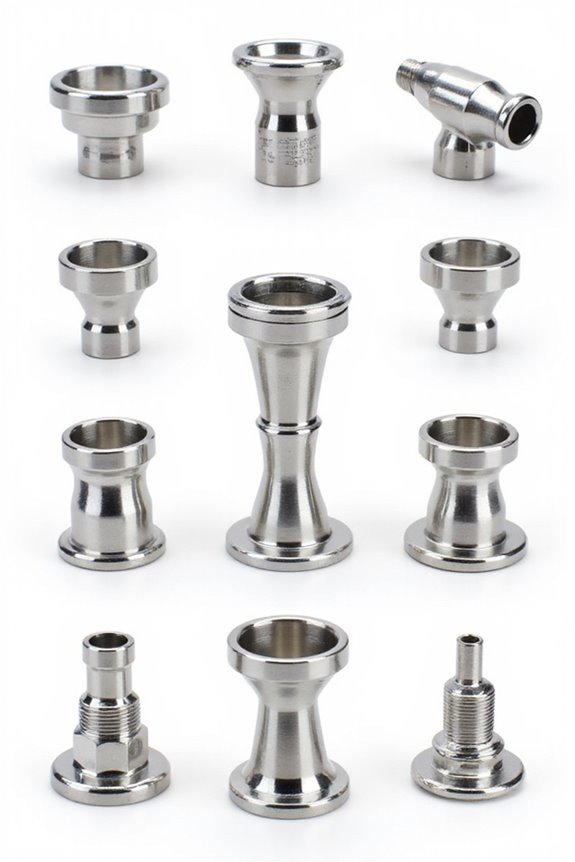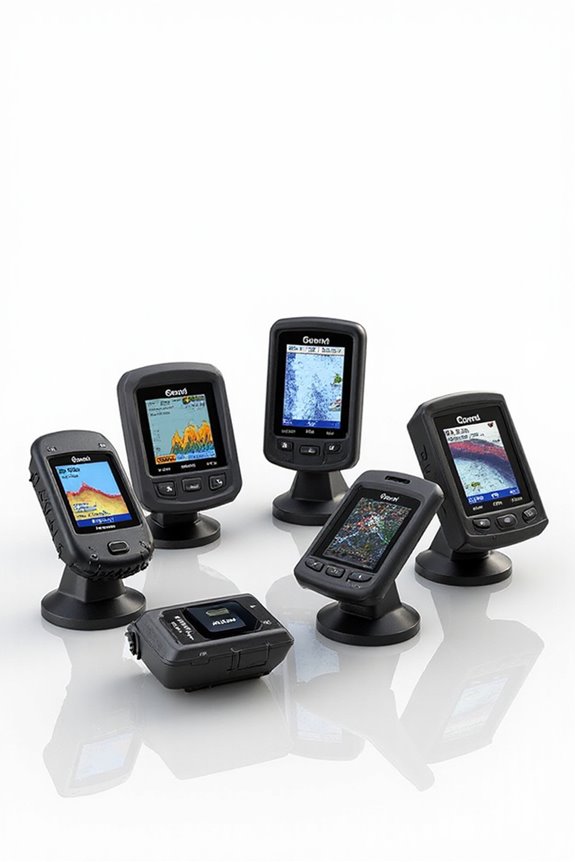As an Amazon Associate, we earn from qualifying purchases. Some links may be affiliate links at no extra cost to you. Although our opinions are based on curated research, we haven't used these products. Articles generated with AI.
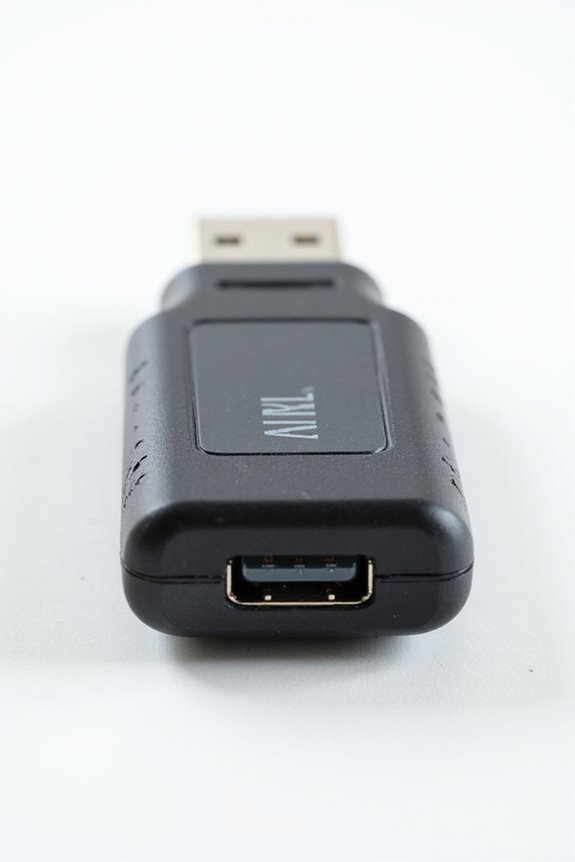
The 5 Best AIS Receiver USB Dongles for Seamless Marine Connectivity in 2025
When you’re out on the water, a solid AIS receiver USB dongle is key for tracking marine traffic. In 2025, the AIS Dongle, Blue shines with its compact design, while the Nooelec RTL-SDR v5 Bundle offers versatility for exploring various signals. You’ve also got to think about antenna placement for ideal reception and software compatibility for smooth operation. Who doesn’t love tech that just works? Stick around to discover more gems in the world of AIS receivers!
Key Takeaways
- AIS Dongle, Blue offers dual-channel real-time ship tracking with a compact design, ideal for maritime use and compatible with laptops and Raspberry Pi.
- Nooelec RTL-SDR v5 Bundle provides a versatile option for monitoring signals across a wide frequency range, suitable for both beginners and experienced users.
- Effective reception of AIS signals requires strategic antenna placement, ideally 10-15 feet high with a clear line-of-sight to maritime traffic.
- Software compatibility is crucial; ensure to choose suitable decoding software and keep it updated to enhance dongle performance.
- Prioritize rugged and weather-resistant AIS receivers for durability in harsh marine environments, balancing size and portability with construction quality.
Logitech Unifying Receiver for Wireless Devices
Logitech USB Unifying Receiver, 2.4 GHz Wireless Technology, USB Plug Compatible with all Logitech...
- Use as an extra Unifying receiver to wirelessly connect a Logitech flow mouse to a second computer and seamlessly cut, paste and move files between screens
- Use this stand-alone USB Unifying receiver to replace a lost one. It's compatible with all Logitech Unifying products (look for Unifying logo displayed on compatible...
- Connects up to 6 Unifying compatible mice and keyboards to Each computer so you don't Sacrifice extra USB Ports
If you’re looking to streamline your workspace with high-quality wireless connectivity, the Logitech Unifying Receiver could be just what you need. This tiny USB dongle uses 2.4 GHz technology, making it compatible with various Logitech devices like mice and keyboards for your PC or Mac. You can connect up to six devices, so no more scrambling for USB ports! It’s designed to stay plugged in, ensuring reliable connections up to 33 feet away. With a solid 4.2 out of 5-star rating from happy users, this little gadget could save you time, space, and a bit of sanity while working.
Best For: Users seeking a reliable and efficient way to connect multiple Logitech wireless devices to their PC or Mac without using multiple USB ports.
Pros:
- Convenience of Connectivity: Connects up to six Unifying compatible devices, conserving valuable USB ports.
- Extended Range: Offers a reliable wireless connection up to 33 feet (10 meters) for flexible workspace arrangements.
- Strong User Satisfaction: Highly rated with 4.2 out of 5 stars from over 17,000 users, indicating overall positive experiences.
Cons:
- Software Installation Issues: Some users reported difficulties with the Logitech Unifying Software installation and setup.
- Replacement Concerns: Lost receivers can complicate multi-device setups and lead to frustration if the wrong dongle is chosen.
- Limited Compatibility with Non-Unifying Devices: Only works with specific Logitech devices, limiting expansion outside of that product line.
Logitech Unifying Receiver for Mouse and Keyboard (C-U0007)
Logitech C-U0007 Unifying Receiver for Mouse and Keyboard Works with Any Logitech Product That...
- Logitech Unifying receiver for mouse and keyboard
- Logitech Unifying receiver (M/N:C-U0007)
- Will work with any product that display the Unifying Logo
The Logitech Unifying Receiver (C-U0007) is a game-changer for anyone who’s tired of juggling multiple USB dongles for their devices. This compact little gadget connects up to six Logitech devices—like mice and keyboards—simultaneously. Imagine cutting the clutter while you work! You just need Logitech’s Unifying Software for pairing, which some users find a bit tricky, but it’s worth it for that seamless experience. At only 0.32 ounces, it won’t hog any USB ports. Just remember, it doesn’t play nice with newer Logitech Bolt devices, so check compatibility first. Say goodbye to USB mess and hello to convenience!
Best For: Users who own multiple Logitech devices and want to reduce USB clutter with a single receiver.
Pros:
- Connects up to six Logitech devices simultaneously, simplifying device management.
- Compact design that preserves valuable USB ports, perfect for laptops.
- Provides a stable wireless connection with minimal latency.
Cons:
- Requires installation of Logitech Unifying Software, which can be challenging for some users.
- Not compatible with newer Logitech Bolt devices, limiting its usability for some.
- Some users report difficulty finding the necessary software and compatibility issues with Windows 10.
AIS Dongle, Blue
ShipXplorer AIS Dongle, Blue
- Decodes and displays AIS transmissions.
- Dual channel reception on 161.975 MHz and 162.025 MHz.
- Compact design. USB 2.0 dongle
Looking for a compact solution to enhance your maritime adventures? The AIS Dongle, Blue might just be your perfect mate! This dual-channel USB receiver allows you to track ships in real-time, decoding transmissions right from the comfort of your boat, laptop, or even Raspberry Pi. Weighing just under an ounce and measuring a mere 3.54 inches, it’s small enough not to hog valuable space. Just plug it in, but keep in mind you might need some software help for advanced features. And hey, remember to mount that antenna high for ideal reception—after all, you wouldn’t want to miss out on any pirate ships!
Best For: The AIS Dongle, Blue is best for maritime enthusiasts and hobbyists looking for a compact and affordable solution to track ships in real-time.
Pros:
- Compact and lightweight design makes it ideal for small spaces.
- Allows real-time tracking of ships, enhancing maritime activities.
- Compatible with various devices such as laptops and Raspberry Pi.
Cons:
- Requires additional software for full functionality, leading to potential setup difficulties.
- Mixed reviews on effectiveness and reception range, especially compared to commercial services.
- Customer support may be lacking, with reports of inadequate follow-up assistance.
Nooelec RTL-SDR v5 Bundle – Software Defined Radio
Nooelec RTL-SDR v5 Bundle - NESDR Smart HF/VHF/UHF (100kHz-1.75GHz) Software Defined Radio. Premium...
- Turn your computer, phone or tablet into a radio scanner/ham radio receiver that can receive nearly all RF signals! Compatible with Windows, Mac OS, Linux, and Android
- NESDR SMArt RTL-SDR v5 can be used for the reception of broadcast AM radio, broadcast FM radio, shortwave radio, CB radio, public security radio, trunked radio, air...
- The best-performing low-cost RTL-SDR available anywhere! Compared with RTL-SDR v3, HF SNR is improved by up to 15dB, VHF & UHF SNR is improved by up to 6dB, tuning...
A standout feature of the Nooelec RTL-SDR v5 Bundle is its incredible versatility, making it perfect for enthusiasts who enjoy exploring a wide range of radio signals. Whether you’re into ham radio or want to tune into air traffic control, this USB dongle’s got you covered from 100kHz to 1.75GHz. With improved signal-to-noise ratios and tuning accuracy, you’ll hear every detail, even those pesky weather balloons! Plus, it’s compatible with tons of devices—Windows, Mac, Linux, and Android. So, grab a cup of coffee and turn your device into a powerful radio scanning tool. You’ll have a blast with this gadget!
Best For: This product is best for radio enthusiasts and hobbyists who want to explore a wide range of RF signals and enhance their receiving capabilities.
Pros:
- Versatile reception: Capable of tuning into numerous frequencies, covering AM/FM radio, air traffic control, and various digital signals.
- High performance: Improved signal-to-noise ratios and tuning accuracy for clearer reception of weak signals.
- Broad compatibility: Works seamlessly with multiple operating systems, including Windows, Mac OS, Linux, and Android.
Cons:
- Learning curve: May require some technical knowledge to fully utilize all features and set up correctly.
- Limited HF reception without additional equipment: Users may need to purchase additional antennas or upconverters for optimal HF performance.
- Passive cooling design: The aluminum enclosure may not dissipate heat as effectively compared to active cooling solutions, potentially affecting long-term use.
Nooelec RTL-SDR v5 Software Defined Radio
Nooelec RTL-SDR v5 SDR - NESDR Smart HF/VHF/UHF (100kHz-1.75GHz) Software Defined Radio. Premium...
- Turn your computer, phone or tablet into a radio scanner/ham radio receiver that can receive nearly all RF signals! Compatible with Windows, Mac OS, Linux, and Android
- NESDR SMArt RTL-SDR v5 can be used for the reception of broadcast AM radio, broadcast FM radio, shortwave radio, CB radio, public security radio, trunked radio, air...
- The best-performing low-cost RTL-SDR available anywhere! Compared with RTL-SDR v3, HF SNR is improved by up to 15dB, VHF & UHF SNR is improved by up to 6dB, tuning...
If you’re looking to enhance your marine connectivity experience, the Nooelec RTL-SDR v5 Software Defined Radio is a fantastic choice. With a frequency range of 100 kHz to 1.75 GHz, you can effortlessly pick up a variety of signals, from ships to weather satellites. Its compact aluminum enclosure houses premium components like a 0.5PPM TCXO, ensuring precise tuning. Users rave about its improved sensitivity and stability, making it beginner-friendly yet powerful enough for experts. Just remember, a good antenna can really make a difference. So, are you ready to explore the world of SDR? You won’t be disappointed!
Best For: The Nooelec RTL-SDR v5 is best for both beginners and experienced users looking to explore diverse RF signals in marine environments and beyond.
Pros:
- Improved sensitivity and stability compared to previous versions, enhancing overall performance.
- Wide frequency range (100 kHz to 1.75 GHz) allows reception of a variety of signals such as ship communications and weather satellites.
- Compact and durable aluminum enclosure with premium components ensures longevity and precise tuning.
Cons:
- Power requirements can be high when used with mobile devices, necessitating a powered USB cable.
- Performance heavily reliant on antenna selection; a good antenna is critical for optimal signal reception.
- Software options vary, with some being open-source while others require a small fee, which may limit user choice.
Factors to Consider When Choosing an Ais Receiver Usb Dongle
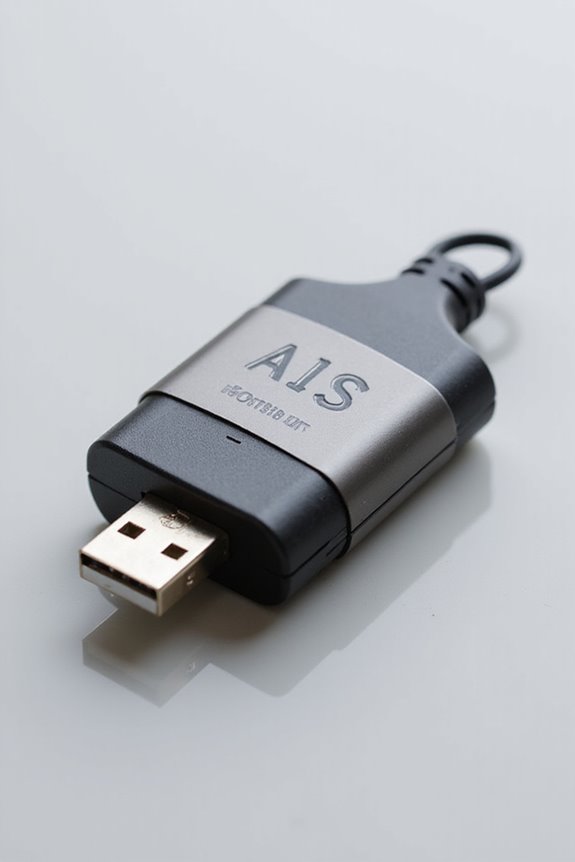
When you’re picking an AIS receiver USB dongle, consider compatibility with your devices—no one wants to buy something that won’t connect! Think about reception range too; it’s what keeps you updated on all the action out there on the water. Don’t forget to review software requirements and installation ease; if it’s too complicated, you might find yourself wishing for a simpler life!
Compatibility With Devices
Choosing the right AIS receiver USB dongle can feel like trying to find the perfect fishing spot—there are a lot of factors to contemplate! Start by checking its compatibility with your operating system. Do you use Windows, Mac OS, or Linux? Not all dongles will work seamlessly with every system. Also, think about your existing hardware; will it connect easily to your laptop or Raspberry Pi? Some dongles are plug-and-play, while others might require additional software—so read the fine print! Don’t forget to verify the frequency range, usually around 161.975 MHz and 162.025 MHz, to make sure you can track all those vessels. And size matters—compact options are great for travel, but some larger models offer better reception.
Reception Range Capabilities
After ensuring compatibility with your devices, the next thing to contemplate is reception range capabilities. You’ll notice that Class B AIS transponders boast a maximum range of 15 miles, but realistically, you might only see vessels around 5-7 miles out. It’s essential to think about where you’ll place your antenna—a higher and unobstructed location often means better reception. Just want to warn you, environmental factors really play a role here; obstacles and interference from other gadgets can mess with your range. Many users will tell you that their experiences vary—some devices shine under great conditions, while others can be downright stubborn. So, do your research and pick wisely for the best marine connectivity!
Software Requirements and Installation
Selecting an AIS receiver USB dongle isn’t just about the hardware; you’ve got to evaluate the software too! Many of these devices need specific software—like AIS catcher—to decode and display the AIS transmissions effectively. You might think they’re all plug-and-play, but hold your horses! Some don’t work until you install their software.
Make certain to check if the software is compatible with your operating system—whether it’s Windows, Mac, or Linux. Installing the right version can be a puzzle; don’t be surprised if you face a few challenges along the way. And remember, keeping that software updated is vital to guarantee your dongle works seamlessly and stays in tip-top shape. Happy sailing!
Antenna Placement Considerations
When it comes to setting up your AIS receiver USB dongle, the placement of the antenna can make all the difference in your reception quality. Ideally, you want that antenna mounted high—think at least 10-15 feet off the ground—so it has a clear line-of-sight to maritime traffic. Keep it away from pesky sources of interference, like buildings or trees, that could block those all-important signals! Don’t forget to point it in the direction where you expect the most AIS traffic for better clarity. And if you need longer cables, consider using a powered USB hub to guarantee your dongle stays energized. Great reception isn’t just luck; it’s smart setup!
Power Management Solutions
Power management solutions are essential in selecting the right AIS receiver USB dongle, especially if you want it to perform at its best. Think about it: inadequate power can lead to frustrating connectivity issues. You’ll want to connect your dongle to a stable power source, which helps it process data more efficiently. Using a powered USB hub can stop those pesky voltage drops that limit your reception range. If you’re using a battery-operated setup, be mindful of power consumption—trust me, you don’t want it failing when you’re out at sea! Placing the dongle near reliable power and away from interference will also keep things running smoothly. After all, you wouldn’t skimp on batteries for a flashlight, would you?
Weight and Size
Weight and size play an essential role when you’re picking out the perfect AIS receiver USB dongle. Who wants a bulky gadget hogging all your USB ports, right? Look for lightweight options, ideally around 0.81 ounces, making them easy to throw in a bag without feeling like you’re carrying a brick. Compact designs, about 3.54 x 0.79 x 0.39 inches, guarantee you can connect effortlessly to laptops and mobile devices. Plus, a smaller dongle can be placed higher up for better signal reception—you’ll get better performance when it’s not fighting for space! So, consider weight and size carefully; you want convenience without compromising functionality. After all, it’s all about seamless connectivity on your marine adventures!
Frequency Support
Choosing the right AIS receiver USB dongle isn’t just about size and weight; frequency support plays a significant role too. You’ll want a dongle that operates on the specific AIS frequencies of 161.975 MHz and 162.025 MHz. Why? Because that’s where all the action happens in ship tracking! Some models even offer dual-channel capabilities, meaning they can receive both frequencies at once—how cool is that? Just remember, the effective reception range, especially for Class B transponders, is typically around 5-7 miles, depending on conditions. Plus, make sure your dongle is compatible with software that processes AIS signals. It’s the magic combo that keeps you updated on maritime traffic. After all, you wouldn’t want to miss a boat out there!
Build Quality and Durability
When it comes to AIS receiver USB dongles, build quality and durability are more than just buzzwords—they’re essential for your maritime adventures. You want a compact design that enhances portability, making it easier to use on your boat or dock. But don’t underestimate the materials; rugged construction can withstand the harsh marine environment. If you’re sailing into the sunset, you’ll need a dongle that resists wear and tear, guaranteeing reliable performance. Lighter models are convenient, but some might sacrifice durability. So, look out for weather-resistant features and rugged casings! After all, you wouldn’t want your dongle to take a dip before you do, right? Prioritize these factors to guarantee smooth sailing on the information superhighway!
Frequently Asked Questions
What Is AIS and Why Is It Important for Marine Navigation?
Think of AIS as your personal lighthouse, guiding you through the sea of vessels. It stands for Automatic Identification System, and it’s vital for marine navigation because it helps you spot other ships, their speed, and direction. Without it, you’re sailing blind! This technology enhances safety—preventing collisions and keeping you informed. So, when you’re out on the water, having AIS means you can navigate with confidence and enjoy the voyage!
Can I Use an AIS Receiver Without a Dedicated Marine Radio?
You definitely can use an AIS receiver without a dedicated marine radio! It’ll give you access to vessel traffic data that’s super useful for safe navigation. Just remember, without a radio, you won’t be able to communicate back. You’re fundamentally a spectator, watching the traffic roll by. It’s like having a front-row seat to a maritime show—just no talking allowed! While it’s handy, consider upgrading to a radio for more interaction.
How Do I Set up My AIS Receiver USB Dongle?
Setting up your AIS receiver USB dongle is as easy as pie! First, plug your dongle into a USB port on your device. Next, download AIS software—like OpenCPN or MarineTraffic—if you haven’t already. Then, configure the software to recognize your dongle as the data source. After that, you’ll receive real-time marine traffic info. Just sit back and enjoy your virtual ocean adventure. Who knew sailing could feel this high-tech?
Are There Any Compatibility Issues With Different Operating Systems?
When it comes to compatibility, you might run into a few hiccups with different operating systems. AIS receiver USB dongles usually work well with Windows and macOS, but Linux users can sometimes face challenges. Don’t worry, though—many popular dongles come with drivers for multiple platforms! Just double-check the specifications before buying, because nobody wants a fancy gadget that won’t play nice with their computer. Who needs that extra frustration, right?
What Maintenance Is Required for AIS Receiver USB Dongles?
To keep your AIS receiver USB dongle in tip-top shape, you should regularly check for firmware updates. Dust it off occasionally—believe it or not, those little specks can cause connectivity issues! You might also want to inspect the USB connector for wear and tear; it’s the unsung hero connecting your system to the marine world. Just like your boat, a little maintenance goes a long way in ensuring smooth sailing.






